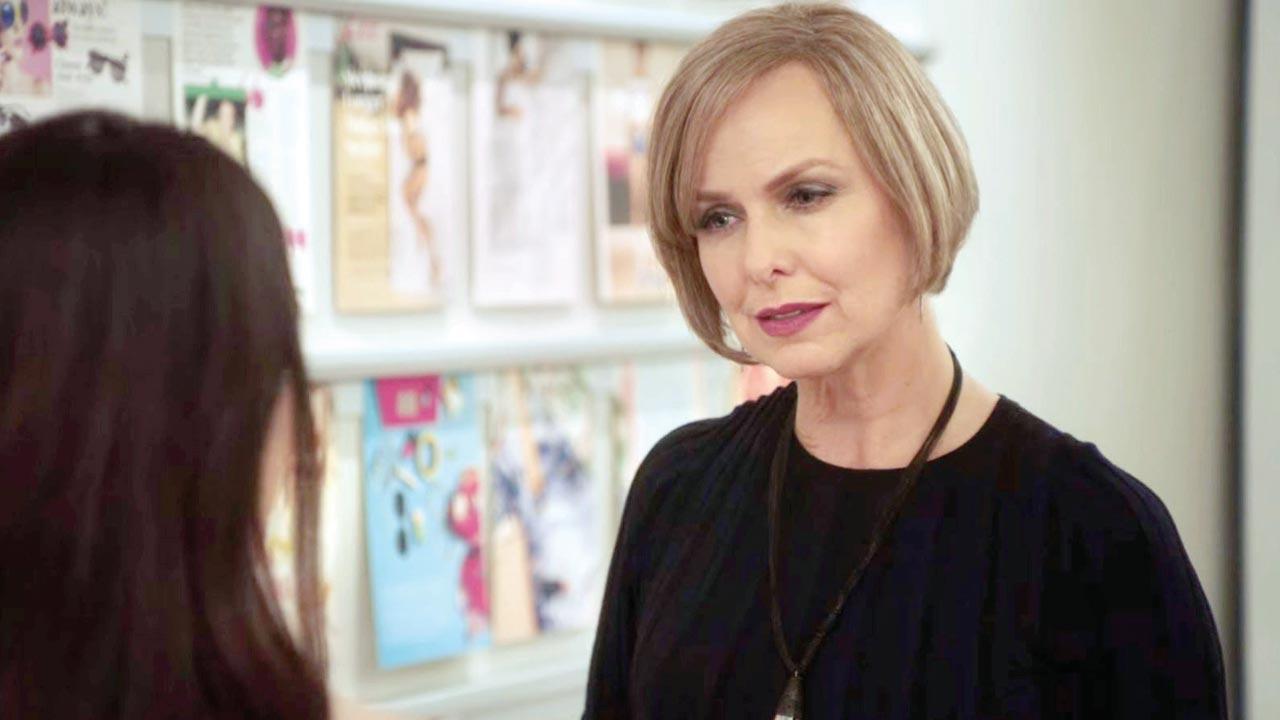While writing requires solitude and absolute focus, crochet is an activity where I enjoy external stimulation. This recently led me to the feminist role model Jacqueline Carlyle in The Bold Type

Jacqueline Carlyle seems intimidating and authoritative, and yet is unflinchingly approachable, caring, genuine, and gives excellent, encouraging advice. Pic/Netflix
I rarely allow for intense external stimulation while in the throes of writing. The act demands focus, and is, for me, the culmination or the consequence of sifting through different forms of matter that have entered my world sensorially during the process of my every day. And so, when I write, I need extreme solitude. I need to be alone. Of course, in dire circumstances where privacy is not possible, I adapt, especially if the urgency to write has enunciated itself strongly enough, if I feel like the writing is spilling forth from my consciousness and needs to be contained.
I should make a distinction here between various forms of writing. On the one hand, there is immense note-taking and journaling that is integral to my process. I record the moments of contact, when my attention falls upon an object and a feeling ensues. I would refer to all of this as a documentation process. As a memoirist, empowered and conscious living constitutes my fieldwork. Everything is indeed copy, and the everything includes all sensuous and intangible matter that manifests across metabolic and poetic registers. One has to practise being consistently alert, even while complacent.
My attraction towards crochet is entangled with these intellectual and emotional pursuits. Unlike the act of writing, while I crochet, I can exercise greater flexibility in terms of external stimulation. Sometimes I enjoy meditatively following a pattern. I refer to the grid that charts out the frequency or sequence of various stitches, moving between rounds, counting as I go along to ensure numerical equivalence. This map exists within the periphery of my focal length. I look at it only when I need to, the rest of the time I am hooked to what is transpiring between my fingers, the conversion of yarn or thread into a pattern, a weave, a decorative object that begins to grow in size and materialize before me.
Sitting invisibly within the loops and chain spaces and stitches are my thoughts. They emerge from within me, and, because I am allowing for stillness, they narrate themselves. Time feels fluid in that the present intersects with the past intersects with future continuous. I may be in the middle of spring but in my head, I’m walking in snow and looking at the trail my borrowed shoes leave on the surface that is immediately concealed by fresh snow.
I have become less anxious because I have been able to unearth this portal through which I navigate the complexity of my fears and insecurities. Instead of repressing what bothers me, I hash it out, I let the emotion flood over me. I don’t hold back. All the while my fingers continue to communicate with the yarn and over the span of either days or weeks, something I began will find itself complete.
The world will see it as a craft item. I will still not have found the vocabulary to communicate the density of this labour, how it is not only physical but involves all my muscles and the cellular part of me responsible for my dreaming, how it was a net upon which I conjured and cast my imagination, allowing it to take shape, be unstable, exist purely as energy.
Sometimes, however, I love to listen to a podcast or watch something while I crochet. It’s pleasurable to have something occur in the foreground that doesn’t demand all your attention but which filters through adequately enough so as to be satiating.
This was how, after having re-viewed the last two seasons of How I Met Your Mother to better understand how its narrative structure was playing with chronology, I began to watch The Bold Type on Netflix. It’s a 2017 series about three twenty-somethings in New York who work at a fashion magazine called Scarlet. I thought it seemed light enough to make for entertaining viewing, with the right ratio of drama and glamour that one expects from such a show.
I found myself unexpectedly drawn to the character of the magazine’s editor, Jacqueline Carlyle (Melora Hardin), who is supposedly based on Cosmopolitan’s editor-in-chief Joanna Coles. She seems intimidating and authoritative, and yet is unflinchingly approachable, caring, genuine, and gives excellent, encouraging advice. Because I’m still working through the trauma of having been fired from my first job at a magazine after having been slut-shamed, body-shamed, and constantly humiliated and berated by my editors, it’s been healing to watch the show and to know that the fault wasn’t mine, that it was never wrong of me to expect to be shown more kindness, compassion, and care by my superiors.
As I gradually embrace the new mentoring role that I am expected to perform as a ‘mentor’ in a program where the ‘fellows’ I’m to guide are professionally more qualified than I am, I’m particularly excited by how various feminist acts of radical listening, kindness, and honesty can subvert the hierarchical nature of relationships. It felt validating to see a television avatar of the feminist role model I wished I’d had then, and to imagine, even retrospectively, what it could have meant to have been ‘held’ professionally.
Deliberating on the life and times of Everywoman, Rosalyn D’Mello is a reputable art critic and the author of A Handbook For My Lover. She tweets @RosaParx
Send your feedback to mailbag@mid-day.com
The views expressed in this column are the individual’s and don’t represent those of the paper
 Subscribe today by clicking the link and stay updated with the latest news!" Click here!
Subscribe today by clicking the link and stay updated with the latest news!" Click here!









